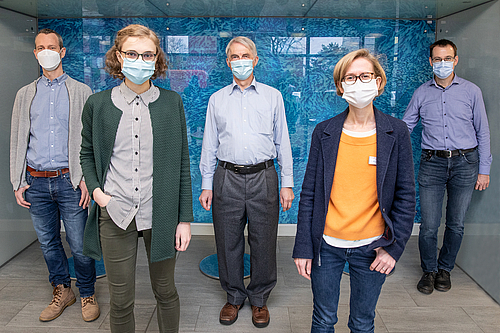A human is made up of about 30 billion body cells – and also many bacteria. Without them, we are not able to exist. Not only in the intestine, on our skin or in the stomach, microorganisms perform important functions. The lung also has a microbiome, a community of bacteria, viruses and fungi, that is essential for the organ to function. A BREATH research team led by Professor Dr. Dr. Burkhard Tümmler, Head of the Cystic Fibrosis Molecular Pathology Research Group at the Clinic of Pediatric Pneumology, Allergology and Neonatology at Hannover Medical School (MHH), has now studied the structural composition of the pulmonary flora in infants and small children with and without cystic fibrosis and found how a healthy microbiome develops in the lower airways. The study has been published in the renowned medical journal Biofilms and Microbiomes.
Microorganisms form a community
„Until recently, the lower airways in humans were considered to be sterile“, Professor Tümmler explains. Thus, most studies would have investigated the microbiology of the lung only in the case of acute infections or chronic pulmonary diseases. „In our study, we collected for the first time cough smears from healthy children aged between three weeks and six years, testing them for the presence of microorganisms and comparing them with those from cystic fibrosis patients of the same age“, the research group leader continues. To do this, the scientists had to overcome various obstacles. One particular challenge was the quality of the samples, since bacteria, viruses and fungi are present everywhere in the air and in water. „In order not to contaminate the samples unwittingly with foreign organisms, we had to be very careful when taking the samples and processing them“, emphasizes Marie-Madlen Pust, doctoral student in the research group and first author of the study. A further difficulty was filtering out the many different types of microorganisms and assigning them correctly. „The respective secretion samples contained only a few nanograms of genetic material and of those about 90 percent originated from the children and only 10 percent from the community of microorganisms“, DZL Academy Fellow Marie-Madlen Pust states. For the analysis, bioinformaticians at the MHH have developed a so-called metagenomic pipeline, produced a readout of the total amount of genetic material of the microbiome using a sequencing machine and then reclassified the vast amount of unclassified DNA data to the relevant microorganisms using high performance computing techniques.
Healthy and sick children occasionally have the same lung microbiome
Scientists have established that the lung microbiome in healthy and sick children in the first three years of their life hardly differs. „They had a very similar composition of various types of bacteria, which apparently interact with one another to form a type of network“, says the first author. Among these are, surprisingly, germs like Staphylococcus aureus or the dreaded cystic fibrosis pathogen Pseudomonas aeruginosa, an environmental bacterium which can be found everywhere – even in drinking water. In the first year of life, although this network is more unstable in children with cystic fibrosis (CF), in two- to three-year-olds there is hardly any difference. Only as the children grow older does the microbiome change again in those with CF. The variety of types of bacteria decreases, the germs prevail and establish themselves chronically in the lung, causing the sensitive network to disintegrate. In contrast, in healthy children the network remains stable, although their lungs display a markedly higher level of bacteria.
„Our study shows that the overall composition of the microbiome is of paramount importance for a healthy lung“, Study Director Prof. Tümmler emphasizes. This cohort of healthy children can be used in future as a comparison for other studies. „Up to now, only the findings from children with different illnesses could be compared“, the DZL scientist explains. For the treatment of cystic fibrosis, the study also provides crucial information: Whilst the treatment of older CF patients is limited, there is clearly a timeframe for young children during which it is possible to favorably influence the biological processes in the lung for the further course of disease.
The study was carried out in cooperation between the German Center for Lung Research (DZL) at the Hannover site of BREATH (Biomedical Research in End-stage and Obstructive Lung Disease Hannover) and the Central MHH Research Unit for Gene Sequencing GENOMICS.
Original publication:
Pust MM, Wiehlmann L, Davenport C, Rudolf I, Dittrich AM, Tümmler B. The human respiratory tract microbial community structures in healthy and cystic fibrosis infants. NPJ Biofilms Microbiomes. 2020 Dec 15;6(1):61. doi: 10.1038/s41522-020-00171-7. PMID: 33319812; PMCID: PMC7738502.
Text: Kirsten Pötzke/MHH
Photos: Karin Kaiser/ MHH

First author and DZL Academy-Fellow Marie-Madlen Pust

Working group: Dr. Colin Davenport, Marie-Madlen-Pust, Prof. Dr. Burkhard Tümmler, PD Dr. Anna-Maria Dittrich and Dr. Lutz Wiehlmann (f.t.l.)